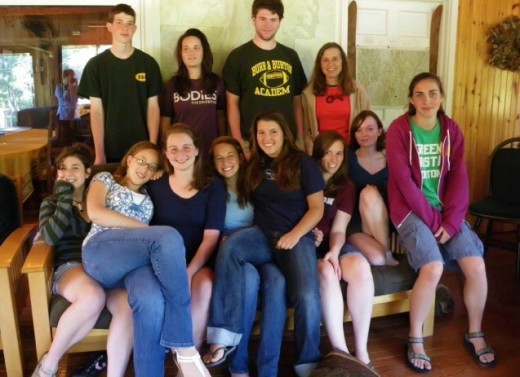Have you ever bemoaned the fact that high school students don’t know much about how local government works or the importance of planning for the community’s future?
If so, are you aware that some cities and towns have taken steps to address this by adding high school student members to their planning commission?
 In this short article, we’ll take a look at three communities that have taken this step. We’ll see how both the community and the students have benefitted — and we’ll consider some of the challenges in setting up this kind of arrangement.
In this short article, we’ll take a look at three communities that have taken this step. We’ll see how both the community and the students have benefitted — and we’ll consider some of the challenges in setting up this kind of arrangement.
The three communities we’ll look at — Manchester and Burlington, Vermont, and Edina, Minnesota — have successfully shown that with a strong youth presence their planning boards are better able to analyze subjects from a larger variety of perspectives while continuing to be an efficient and effective resource for their communities planning staff. All three places have made a conscious effort to recruit local students to serve on their planning boards, and by all accounts these efforts have been rewarded.
When properly motivated and engaged, student planning board members can illuminate issues that may have otherwise gone unnoticed and expand the conversation among the voting commissioners.
Manchester, Vermont
Manchester, Vermont, is a small town (population about 4,000) located in the southwestern part of the state. If you’re a skier (or an outlet shopper) you may have heard of Manchester, as it’s one of the gateways to several of the state’s ski areas. Lee Krohn, Manchester’s long-time planning director has, since 2007, effectively integrated students into planning boards with a high level of success.
Through a partnership with Burr and Burton Academy in Manchester (an independent secondary school that serves as the public high school for students from Manchester and is offered as a school of choice for several surrounding communities) and supported by the Orton Family Foundation, the town government appoints two student members to not just the planning commission but to each of six additional government boards.
The Town of Manchester uses the same rigorous selection and interview process that is used when choosing adult board members. On all but two of these boards (the planning commission and the development review board) the student members have full voting privileges. Even on the planning commission, where students do not have a vote on all matters, student members have had a strong and overwhelmingly positive effect on the discussions and final decisions of the commission.
The students have, according to Krohn, provided great new insights, shifting many of the ways adult members conceptualize their communities. Prior to having student members on each government board, Krohn notes, there was a definite lack of student voice. There was a need to emphasize the thoughts of those who will “inherit the future.”
Hayden Dublois, a former student member of the Manchester Planning Commission, felt his impact was greatest during the reformulation of the town plan. “As we went through the document, paragraph by paragraph, I offered amendments to existing language. Often these amendments became a part of the plan.” The perspectives of students, according to Dublois, are even more far reaching, affecting the outcome of many issues, such as temporary residential structures, zoning, and sign variances.
Within a few years, the success of the Manchester Planning Commission youth engagement gained national recognition by the American Planning Association (APA) and three students accompanied Krohn to the APA’s annual conference in Minneapolis to present the various ups and downs that come with their appointment to the town boards.

Is the success of the Manchester’s youth engagement the result of an unusual population of students who are somehow inherently more interested in local planning projects than would be the case in other communities? Krohn doesn’t think so. Instead, several factors in the program design were key.
First, the Town’s approach to youth engagement focused on how serving on a board would ultimately serve the student’s interests, instead of simply portraying the program as a way to aid a group of adults in making decisions.  Manchester framed their student engagement ideas around the opinions, experiences, and suggestions of the local students themselves. Five Burr and Burton high school students served as members of the committee charged with developing a youth engagement model in 2006, the model that would, by the next year, open up the seven local government boards to student membership.
Manchester framed their student engagement ideas around the opinions, experiences, and suggestions of the local students themselves. Five Burr and Burton high school students served as members of the committee charged with developing a youth engagement model in 2006, the model that would, by the next year, open up the seven local government boards to student membership.
Also, by opening up board seats for students on multiple boards with different roles Manchester accessed a greater percentage of the student population than if the town were looking for just one student to serve on, say, the parks and recreation committee or on the planning commission.
 For the students, too, there is strong encouragement and incentive. The high school, through its service learning graduation requirement, encourages students to participate in local government.
For the students, too, there is strong encouragement and incentive. The high school, through its service learning graduation requirement, encourages students to participate in local government.
The program, Krohn states, is not only a great, practical partnership between the high school and the town of Manchester, but is a way for students to have a sense of place and see the value in community development.
This definitely resonated with Dublois, who, after completing the program, had a much clearer sense of how town committees work to represent residents and their community as a whole. In a larger sense, Krohn sees the program as planting a seed of interest in local government that will transcend this singular experience, encouraging students to carry on participating in their communities’ decisions for the rest of their lives.
A more detailed look at the Manchester youth engagement program is available on the Orton Family Foundation web site.
Edina, Minnesota
Edina, Minnesota, situated less than ten miles southwest of Minneapolis, is considered a first-ring suburb. With a population of almost 48,000 and a territory of sixteen square miles, Edina is considerably larger than Manchester. Its student involvement program has been in place for ten years, the application process being channeled through the high school. Two spots are reserved for students on the Edina Planning Commission. Student applicants are interviewed by members of the City Council for the positions.
The program allows active participation of students in all planning commission meetings, where, according to Cary Teague, Edina’s Community Development Director, they are “welcome to participate in the discussions and provide input.” However, voting abilities do not come with their participation. Unlike in Manchester, the students do not receive any credit or meet a school requirement. However, their volunteer hours look great on resumes and college transcripts as a display of interest in the inner workings of their community.
The students’ participation on the planning commission has contributed to better decision making, providing a “fresh perspective” to local concerns and problems. As Teague notes, Edina has been “very lucky to have had very bright students that are willing to participate.”
Burlington, Vermont
Burlington, Vermont, located on the waters of Lake Champlain, is Vermont’s largest city, with a population of about 42,000.
Burlington’s program for youth participation began in 2003, with students serving on the planning commission; it has since expanded, with students now also sitting on a variety of committees. Burlington High School students receive credit for this service. In addition, their volunteer hours look tremendous on a college application or resume. More importantly, as Yves Bradley, current Chair of the Burlington Planning Commission, informed us, students “feel that they are benefiting the community.”
While the students do not have the power to vote, their input and participation is greatly valued. Their unique perspectives allow the commission to view issues more broadly across the entire community, seeing the impacts of decisions not just on adults, but on youth as well. According to Burlington Planning Director David White, “in some ways, even though students can’t actually vote, they can possess disproportionate power because the other commissioners really want to hear what they think.”
Despite Burlington, Vermont’s generally positive experiences with student planning board members, White notes that the success “depends greatly on the interest and personality of the student. If they are wall-flowers, it is boring and little is offered or learned.”
Unlike Manchester or Edina, Burlington has not seen as consistent an interest from local high school students in joining the planning commission. Part of the reason for this, according to White, is that many students are not familiar with the function of the planning commission and how it may relate to the student’s academic or extracurricular interests. To counter this, it is important to educate student populations on the widespread impact that planning commission decisions can have, and how these decisions can affect a student’s daily life.
Former Burlington Planning Commission student member Andrew Saba echoed this sentiment, noting that the impacts of decisions made through planning should be highlighted to students. Additionally, he observed, illuminating the connection between city planning and broader academic topics such as history, economics, and government could further broaden student interest in serving on the planning board.
Embracing our Youth
Politicians are always exclaiming that “our children are the future” and that their decisions will ultimately shape the societies that we live in. As has been shown by communities like Manchester, Edina, and Burlington, instead of just rhetoric about how our young people will shape our communities’ future, local governments can embrace and support programs like student membership on the planning commission and other local boards. If the youth of our nation will eventually become the most powerful policy makers, why not set them on the correct path today?
 When a planning board is able to add interested and dedicated students to their ranks the community also benefits. Allowing a different generation with separate opinions, interests, and priorities to voice their thoughts in a constructive and established environment can create a more complete approach to forming and implementing planning projects. Students also learn about the role of planning, and how it can affect issues facing their community.
When a planning board is able to add interested and dedicated students to their ranks the community also benefits. Allowing a different generation with separate opinions, interests, and priorities to voice their thoughts in a constructive and established environment can create a more complete approach to forming and implementing planning projects. Students also learn about the role of planning, and how it can affect issues facing their community.
But questions remain as to how to best implement student participation on the local planning commission. We have highlighted three communities’ approaches. But we look forward to hearing your comments. What mechanisms do you think could increase youth interest and participation in local government? How can communities better integrate their functions and daily proceedings with the lifestyles and interest of high school students? What sorts of associations, for students, would encourage linkages, relationships, and a willingness to engage with local government?
 Casey Green is a native of Burlington, Vermont, who graduated from The College of Wooster in Ohio in 2012 with a degree in International Relations and History.
Casey Green is a native of Burlington, Vermont, who graduated from The College of Wooster in Ohio in 2012 with a degree in International Relations and History.
Casey is an avid traveler and runner and has spent time living in and studying cities and cultural groups in Peru and Kenya. He resides in Boston, Massachusetts, where he works for a non-profit called Playworks as an elementary school athletics coach and teacher.
 Dan Rosenblum is a senior at the University of Vermont, studying anthropology, global studies, and Spanish.
Dan Rosenblum is a senior at the University of Vermont, studying anthropology, global studies, and Spanish.
Dan is interested in global urban development, especially in major world cities and how it intersects with social and cultural issues. He is applying for future studies of India’s growing urban centers.
Update: Nov. 13, 2013:
Editor’s Note: We received the following message from Alece Montez, a Senior Associate with the Orton Family Foundation: “After doing a survey with all the high school students (approx. 400), Cortez, Colorado, learned that over 50 youth wanted to have more of a role in decision-making. Through a Heart & Soul Community Planning project, the City hosted a youth/adult partnership training and now the City requires youth members on several boards and committees. No better way to groom future leaders and do more with what Pew’s research shows on who moves and who stays.